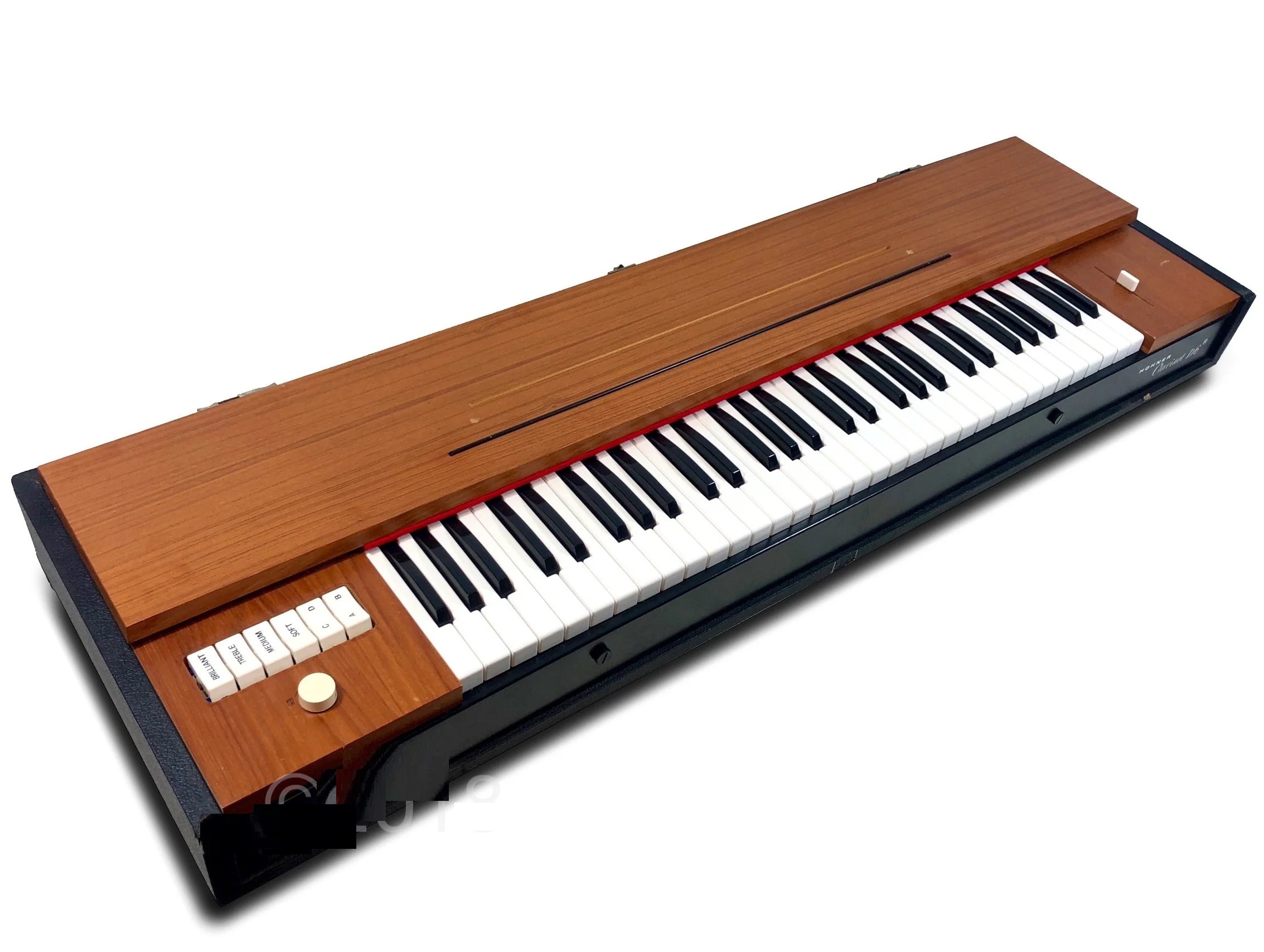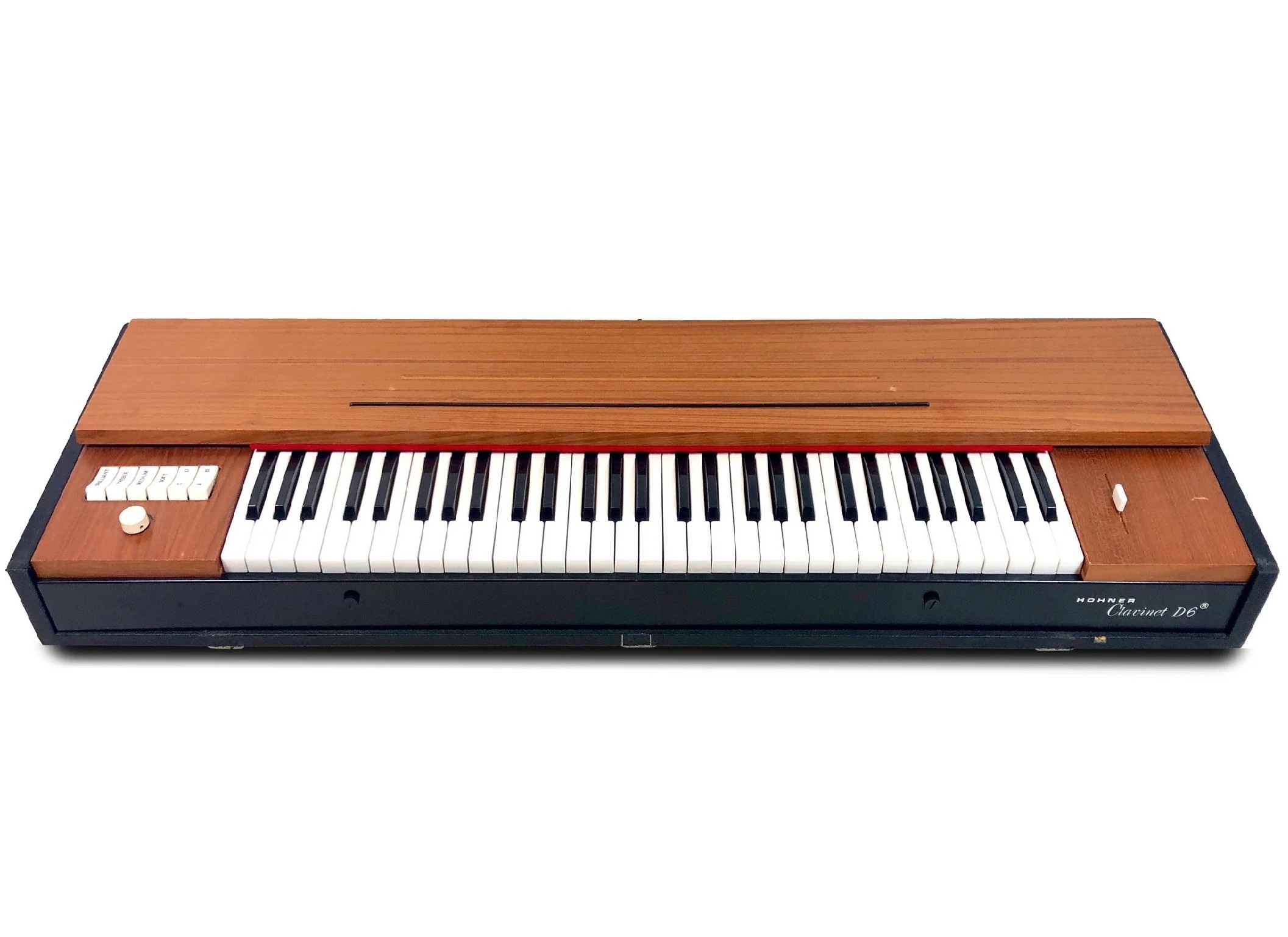Clavinet
Keyboard Instruments
Europe
Between 1901 and present
Video
The Clavinet is an electromechanical keyboard instrument designed to emulate the clavichord, a Renaissance-era stringed keyboard. It was manufactured by the German company Hohner between 1964 and 1982. The instrument produces sound using a mechanism where rubber pads strike tensioned steel strings when keys are pressed.
These vibrations are then converted into electrical signals by electromagnetic pickups, similar to those in electric guitars. The Clavinet’s sharp, percussive tone and dynamic range make it versatile for both rhythm and melody. The standard Clavinet features 60 keys spanning five octaves (F1 to E6). It is often paired with an amplifier to enhance its sound output. The instrument’s design allows for expressive playing styles, including aftertouch effects and volume dynamics, making it a favorite among musicians seeking a unique tonal palette.
Type of Instrument
The Clavinet belongs to the family of stringed keyboard instruments and is classified as an electromechanical device. While it shares similarities with traditional acoustic instruments like the clavichord, its amplified sound and modern design place it firmly in the category of electric keyboards. Its unique construction bridges the gap between acoustic string instruments and electronic sound production.
Origins and Invention
The Clavinet was invented by Ernst Zacharias, a German engineer working for Hohner in Trossingen, West Germany. It was first introduced in 1964 as an electronic adaptation of the clavichord. The instrument was initially intended for home use but quickly gained popularity among professional musicians due to its distinctive sound. The Clavinet’s development took place in Europe during the mid-20th century, specifically in the 1960s. This period saw significant advancements in electronic musical instruments, with innovations like synthesizers and electric pianos emerging alongside the Clavinet. Its prominence peaked in the 1970s and 1980s when it became a staple in funk, rock, reggae, and disco music.
The Clavinet is strongly associated with legendary musician Stevie Wonder, who used it extensively in his 1972 hit “Superstition.” Its funky tone became synonymous with the sound of the era, influencing countless artists and genres. Even today, its legacy endures through digital emulations and dedicated repair communities.
Construction and Design
The Clavinet’s construction is a marvel of engineering that combines mechanical precision with electronic innovation:
String Mechanism: The instrument features 60 tensioned steel strings arranged diagonally beneath the keys. Each string is tuned using machine heads located at the front of the harp.
Key Action: Each key pivots on a fulcrum and is equipped with a rubber pad that strikes the string upon depression. This mechanism closely resembles guitar fretting or tapping techniques.
Pickups: Two electromagnetic pickups are positioned above and below the strings to capture vibrations. These pickups are encased in epoxy for durability.
Damping System: Yarn weaves through one end of each string to dampen vibrations when keys are released.
Preamplifier: A solid-state preamplifier boosts the signal for amplification. Controls for volume and pickup selection are located near the keyboard.
Materials: The body is typically made from wood or composite materials, providing both durability and resonance.
This intricate design enables the Clavinet to produce its signature bright, staccato sound while allowing for nuanced expression.
Types of Clavinets
Over its production run, Hohner released several models of the Clavinet:
Clavinet C: The original model introduced in 1964.
Clavinet L: Featured an integrated speaker system for standalone use.
Clavinet D6: The most iconic model, known for its reliability and tonal versatility.
Clavinet E7: An updated version with enhanced electronics and durability.
Clavinet/Pianet Duo: Combined features of both instruments for expanded functionality.
Each model offered unique features tailored to different performance settings while maintaining the core characteristics of the instrument.
Playing Techniques and Sound Modifications
The clavinet is renowned for its expressive and rhythmic capabilities, making it a staple in funk and soul music. Playing techniques emphasize staccato strikes, syncopated rhythms, and dynamic articulation. The instrument responds well to short, percussive playing styles that mimic the attack of a guitar string. For instance, players often use a sixteenth-note pattern to achieve a funky groove, alternating between chords and bass notes with both hands. Techniques such as rocking the hand between chord halves or alternating notes within a scale add complexity and variation to the sound.
Sound modifications on the clavinet are achieved through its six rocker switches, which control tone settings like “Brilliant,” “Treble,” “Medium,” and “Soft,” as well as pickup combinations labeled “D C” and “B A.” These switches allow players to tailor the timbre from sharp and cutting to mellow and subdued tones. Additionally, volume pedal techniques are essential for controlling dynamics during performance. By adjusting the pedal, players can boost volume during sustained notes or solos.
Applications in Music
The clavinet has been widely used across genres such as funk, R&B, rock, and reggae due to its guitar-like tonal qualities. It gained prominence in the 1970s, epitomized by Stevie Wonder’s iconic use in “Superstition.” The clavinet’s rhythmic precision made it ideal for adding depth to bass lines and creating infectious grooves. In reggae music, it often complements offbeat rhythms, while in rock, it adds a gritty edge to compositions. Modern applications extend beyond live performances to studio recordings where producers use clavinet patches on digital keyboards for its distinct sound. Instruments like Yamaha keyboards incorporate clavinet presets with effects like wah-wah controlled by key velocity, enabling players to emulate classic funk grooves digitally.
Most Influential Players
Several musicians have shaped the clavinet’s legacy:
Stevie Wonder: His masterful use of the clavinet in tracks like “Superstition” showcased its potential as both a rhythmic and melodic instrument.
Billy Preston: Known for his energetic performances on the clavinet during collaborations with The Beatles and Rolling Stones.
Joe McGinty: His nuanced approach highlighted the instrument’s expressive capabilities in live performances with The Psychedelic Furs.
Herbie Hancock: Integrated clavinet sounds into jazz-fusion works, expanding its versatility beyond funk.
These artists demonstrated the clavinet’s adaptability across musical styles, solidifying its place in modern music.
Maintenance and Care
Proper maintenance is crucial for preserving the clavinet’s functionality. Regular cleaning of its keys and strings ensures optimal sound production. The instrument’s pickups should be checked periodically for wear or damage since they play a vital role in sound output. Volume pedals require calibration to maintain smooth transitions during dynamic changes. Players should avoid exposing the instrument to extreme temperatures or humidity levels as these can affect its wooden components. When not in use, covering the clavinet protects it from dust accumulation. For electromechanical models like the Hohner Clavinet, occasional servicing by a professional technician may be needed to ensure that internal mechanisms remain intact.
Cultural Significance
The clavinet holds a unique place in musical history due to its association with funk and soul genres. Its distinctive sound became synonymous with 1970s funk culture, embodying themes of rhythm and groove that defined an era of danceable music. Beyond funk, its influence extended into reggae and rock, where it contributed to genre-defining tracks. The instrument also symbolizes technological innovation in keyboard design. By combining mechanical string strikes with electronic pickups, it bridged traditional acoustic techniques with modern amplification methods. This innovation inspired subsequent generations of keyboard instruments.
In contemporary culture, the clavinet continues to be celebrated through digital recreations and sampled sounds in electronic music production. Its legacy persists as a reminder of how musical instruments can shape cultural movements
FAQ
What are the main features of the Clavinet?
The Clavinet is an electric keyboard instrument with a bright, percussive sound, resembling a funk guitar. It uses rubber-tipped hammers and amplified strings for its signature tone. Its touch-sensitive action allows expressive playing. Popular in funk, rock, and reggae, it became iconic in the 1970s.
How is the Clavinet constructed?
The Clavinet consists of a wooden casing, metal strings, rubber hammer tips, and electromagnetic pickups. When keys are pressed, hammers strike the strings, generating vibrations that pickups convert into an electric signal. It has a simple yet effective design for a dynamic, plucky sound.
Which musicians are famous for playing the Clavinet?
Stevie Wonder popularized the Clavinet with his hit “Superstition.” Other notable players include Billy Preston, Herbie Hancock, and John Paul Jones of Led Zeppelin. It remains a staple in funk, rock, and jazz fusion, adding a unique rhythmic texture to recordings and live performances.
 Links
Links
References
Other Instrument
Categories



















